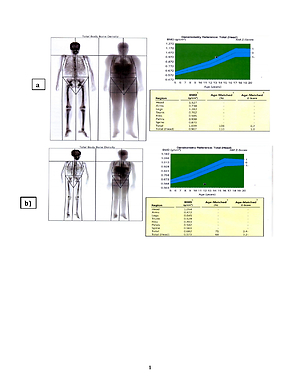Current issue
Archive
Manuscripts accepted
About the Journal
Editorial office
Editorial board
Section Editors
Abstracting and indexing
Subscription
Contact
Ethical standards and procedures
Most read articles
Instructions for authors
Article Processing Charge (APC)
Regulations of paying article processing charge (APC)
PEDIATRICS / RESEARCH PAPER
A high prevalence of low bone mineral density in children with glycogen storage disease type III
1
Cairo University, Pediatrics Department, Egypt
2
Cairo University, Rheumatology Department, Egypt
3
Cairo University, Orthopedics department, Egypt
4
Cairo University, Pediatrics department, Egypt
Submission date: 2021-06-21
Final revision date: 2021-08-16
Acceptance date: 2021-09-07
Online publication date: 2021-09-17
KEYWORDS
TOPICS
ABSTRACT
Introduction:
Glycogen storage disease III (GSD III) is an inborn error of carbohydrate metabolism that involves mainly the liver and skeletal muscles with rare potential systemic complications as osteoporosis. The aim of work of the current study was to screen children with GSD III for osteoporosis using Dual-emission-X-ray absorptiometry (DXA) scan and to measure associated parathormone (PTH) and vitamin D. Our secondary objective is to correlate between the degree of osteoporosis and the muscle state as well as the metabolic control.
Material and methods:
This cross sectional study included 25 GSD III pediatric cases. The liver biochemical profile, creatine kinase (CK), vitamin D2, PTH levels were tested in addition to electromyogram (EMG), echocardiography and DXA. Twenty-five age and sex matched normal healthy controls were subjected to vitamin D2 analysis and compared to cases.
Results:
The mean ±SD age of the patients was 10.52 ± 3.1 years ranging between 5-18 years. Twenty-one patients (84%) had elevated CK levels, 14 patients (56%) had myopathy and three (12%) had sensory polyneuropathy and almost half of the patients had a mild degree of cardiac muscle hypertrophy. Ten patients (40%) had elevated PTH levels. Twenty-one patients (84%) and 96% of the controls had vitamin D2 deficiency. Thirteen patients (52%) had low BMD; two of them had osteoporosis. Patients with high CK levels significantly had low BMD (P= 0.04).
Conclusions:
Pediatric GSD III patients have a significant prevalence of developing low BMD. It is strongly associated with myopathic changes but not significantly related to metabolic control.
Glycogen storage disease III (GSD III) is an inborn error of carbohydrate metabolism that involves mainly the liver and skeletal muscles with rare potential systemic complications as osteoporosis. The aim of work of the current study was to screen children with GSD III for osteoporosis using Dual-emission-X-ray absorptiometry (DXA) scan and to measure associated parathormone (PTH) and vitamin D. Our secondary objective is to correlate between the degree of osteoporosis and the muscle state as well as the metabolic control.
Material and methods:
This cross sectional study included 25 GSD III pediatric cases. The liver biochemical profile, creatine kinase (CK), vitamin D2, PTH levels were tested in addition to electromyogram (EMG), echocardiography and DXA. Twenty-five age and sex matched normal healthy controls were subjected to vitamin D2 analysis and compared to cases.
Results:
The mean ±SD age of the patients was 10.52 ± 3.1 years ranging between 5-18 years. Twenty-one patients (84%) had elevated CK levels, 14 patients (56%) had myopathy and three (12%) had sensory polyneuropathy and almost half of the patients had a mild degree of cardiac muscle hypertrophy. Ten patients (40%) had elevated PTH levels. Twenty-one patients (84%) and 96% of the controls had vitamin D2 deficiency. Thirteen patients (52%) had low BMD; two of them had osteoporosis. Patients with high CK levels significantly had low BMD (P= 0.04).
Conclusions:
Pediatric GSD III patients have a significant prevalence of developing low BMD. It is strongly associated with myopathic changes but not significantly related to metabolic control.
Share
RELATED ARTICLE
We process personal data collected when visiting the website. The function of obtaining information about users and their behavior is carried out by voluntarily entered information in forms and saving cookies in end devices. Data, including cookies, are used to provide services, improve the user experience and to analyze the traffic in accordance with the Privacy policy. Data are also collected and processed by Google Analytics tool (more).
You can change cookies settings in your browser. Restricted use of cookies in the browser configuration may affect some functionalities of the website.
You can change cookies settings in your browser. Restricted use of cookies in the browser configuration may affect some functionalities of the website.



